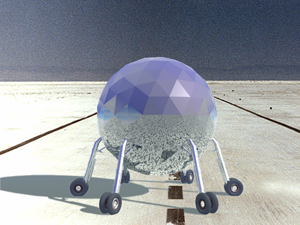
 This
is a US military based campaign in the Ex Tempore universe. The PCs are
assumed to be members of the US military or civilian experts involved
in "Project Tetragon 411". It is assumed that they are reasonably sane,
loyal and skilled enough to be assigned to a top secret project.
This
is a US military based campaign in the Ex Tempore universe. The PCs are
assumed to be members of the US military or civilian experts involved
in "Project Tetragon 411". It is assumed that they are reasonably sane,
loyal and skilled enough to be assigned to a top secret project.
The character sheet is an altered version of a standard Storyteller games sheet, given a slightly more military bent. Before starting the campaign, make sure each character fills out the classified information nondisclosure agreement (form 312).
Background
Dr Ezra Watson was a theoretical physics prodigy, well known for his contributions to particle physics in the early 90's. By the end of the decade he had largely vanished into obscurity, his colleagues sadly commenting on how his manic personality had driven a fine mind from serious science into fringe pursuits. He didn't care, taking minor academic appointments to fund his erratic research into everything from cold fusion to macroscopic Casimir forces.
But even a blind hen can sometimes find a grain of corn. During an experiment in Farnsworth-style desktop fusion he discovered that placing a certain configuration of gadolinium rods in an oscillating electromagnetic field could make an electron beam vanish. Investigating further he discovered that he could actually move the electrons slightly in time. Drawing on his remaining academic contacts and gambling everything he had on an impressive demonstration, he got DARPA interested. They repeated his experiment and found similar results. The "Watson effect" was real.
Tetragon 884
The possibility of time travel (officially called "displacement technology") was too much to pass up on, and a project to study it was set up. It was code-named Tetragon 884, and after some initial experiments it was moved to White Sands Missile Range. Partially this was for security, partially because some worrying experiments suggested that the phasing fields could be dangerous. Dr Watson was kept as a consultant, the projects "tame mad scientist" - while most involved researchers found him cheerful and unorthodox company working hard on realising the project, it was tacitly agreed that he was quite nuts. That his math also managed to explain where phased objects reappeared just made him indispensable (incidentally, the theory he developed was largely wrong, but happened to produce roughly the right answers - it was a first order approximation to the full phasing theory known in Ex Tempore).
The researchers at Tetragon constructed several "DiDis", Displacement Devices, using the Watson effect. The main DiDi is the stationary TTEC-2 ("Tecton"), able to transfer several kilograms with high precision into the future and past. Tecton looks like a cage of electromagnetic effectors, connected to major banks of capacitors and several remote supercomputers doing the necessary calculations. After studies using Tecton had showed how to create a sufficiently extended displacement field a mobile version - Adam - was constructed and sent into the future. Adam unfortunately failed due to a field inhomogenity, but its successor Bernie has done several time displacements with minimal damage. It is a suitcase-sized piece of electronics surrounded by long metal rods, looking a bit like a technological urchin.
Today Tetragon involves several subprojects. The foundation project simply seeks to understand what is going on and how the displacement process can be refined. This is the playground of Dr Watson and an elect crew of physicists. The vehicle project is working on a manned displacement vehicle, the Calvin, while the independence project is working on creating and testing unmanned displacement devices. That so much effort is being put into the Calvin causes no end of good-natured bickering between the projects.
The overall mood is not unlike Los Alamos in the 1940's: everybody knows they are making history, and things are moving faster than anybody can foresee. Although it is seldom spoken of, most participants expect Tetragon to lead to an effort to send back intelligence information (or soldiers!) to prevent the events of 11th September.
The boss at the site is Lt-Gen Maria Walker-Nuņez, a highly capable woman. Selected partially because of her earlier skunkwork project management successes, partially for her ability to plan ahead in uncertain technologies and partially because of her known affinity for speculative fiction, she was the right woman for the job. She keeps an efficient shop and quietly concentrates on figuring out the implications of the technologies that are developed.
She rapidly realised that phasing was enormously powerful - too powerful. Even as mere teleportation it would completely wreck existing military doctrines and defences: how do you protect yourself from an enemy who could teleport grenades past any amount of armour - or teleport bombs untraceably into the Oval office from across the world? Some of the ideas her researchers came up with, like phasing together great masses from numerous small, could in principle produce new kinds of strategic weapons. But it was the ease of time travel that worried her most. The devices built by Tetragon were not particularly complex. Anybody with the design could in principle build it with parts from Radio Shack and a few gadolinium rods. This was not just a normal security issue, because it was enough that the design became known at any time and the time travel spirit would be out of the bottle. The US was entirely undefended against visitors from the future. A future Osama bin Laden could strike anywhere in the past, and there was nothing anybody could do about it.
While Walker-Nuņez did know she was not responsible for deciding any US temporal security doctrine, she also realised that she had to come up with something. She could not let loose the results of Tetragon without finding a way of protecting the US. She does not want to get Washington involved until she knows she has devices ready she can trust. The pressure to use them in the War Against Terrorism would be intense, and she does not trust how much time there will be for careful research and evaluation as soon as Washington starts to order their use. All it takes is one leak anytime in the future, and disaster could happen. Hence she tries to keep Tetragon very much out of sight and avoid revealing too much to anybody on the outside, even those who normally should be entitled to full information.
At the same time she is planning for the future. She thinks that the only way of handling the technology would be to have some kind of "temporally safe" base from which any attempts to twist history could be averted. Hence her promotion of the otherwise ridiculous Calvin project. She also has begun to assemble a team of "chrononauts" to use the vehicle. The final piece was when Dr Watson discovered "temporally stable points": his equations firmly predict that there has to exist at least one "location" that will not be affected by time travel.
This produced her plan for "Operation Fukyama" (it was named after the author of the book The End of History). The plan is to have a US force present at the stable point: if anything happens to the timeline, they will be able to go back in and fix it. It would be a safeguard against time terrorism. That it is an entirely unsanctioned plan that risks much doesn't worry her: she would prefer a court martial to leave the US open to temporal attack. She is even ready to risk some brave men on this plan (or go herself, if necessary) given the stakes.
Events
Original timeline
Day -2
Walker-Nuņez receives two worrying pieces of information. The first is that a presidential meeting has been moved ahead a month, implying that the president will be briefed shortly about project Tetragon. This is bound to cause interest in Washington, and at that point she better have some good stuff to demonstrate.
The second piece is worse. At the onset, project Tetragon was just a somewhat wacky research project - the responsible parties did not truly believe it would work or contribute anything - so the security level of its documentation was merely Confidential. Later, after the demonstrations of true time displacement, it was upgraded to Top Secret. But some of the old Confidential documents apparently were missed, and were part of a document collection that recently was spilled. The idea might be out there.
Day -1
Walker-Nuņez decides to bet on Operation Fukyama, and not just scout "the end of time" with an unmanned probe but to use the chrononaut team to correct any tampering that occurs. The risk that competing projects are already starting (or will start) is too high. She formulates a contingency order for the crew to protect US temporal integrity.
Day 0
Operation Fukuyama goes ahead, despite some protests from the support crew. At 9:00 MTZ the Calvin Coolidge leaves the timestream. It does not return.
Day 1
Still no sign from the crew. Washington representatives appear on the scene, and the situation starts to become problematic for Walker-Nuņez.
Day 17
Walker-Nuņez is replaced by Lt-Gen Edward E. Smythes, an old friend of the vice-president and with ties to the NSA. He rapidly gathers information about the capabilities of the project and presents to the National Security Council.
Day 43
After some tests of transmitting intelligence information Smythes is confident about the technology. He considers sending people too risky, but is very convinced that it is not necessary: just sending a cache of information with suitable identifications back in time to a pickup point is enough to do an enormous amount of good.
At a secret meeting of the National Security Council he reveals his plan to undo 911. After some discussion it is agreed that it is worth it. Day 58 Tetragon sends back information to prevent 911. The non-effect of the operation convinces many agencies the whole project is a charade. After all, they are still there (as is Osama).
Timeline 2
July 2001
The information cache arrives to the NSA, causing much security confusion.
September 2001
The information has been validated, and used to prevent the hijackings. The NSA reveals its catch to the National Intelligence Council and the president. Although there is plenty of disbelief, the evidence is strong. Lt-Gen Edward E. Smythes is promoted to his surprise - he has never heard of Tetragon. There is some discussion about Walker-Nuņez, but in the end the department of defense decides to brief her and advice against Operation Fukuyama. She retains (is given?) control over the project, which is directed more towards unmanned intelligence transmission. A system for intelligence displacement is set up.
Timeline 3-8
Intelligence information is moved backwards, causing the premature start of versions of Tetragon. In a few timelines different agencies begin to use their own displacers.
Timeline 9
Strategic intelligence information is delivered to 1971, far earlier than any previous displacement. The result is an eventual nuclear war.
See The Big D for a more detailed description.
Arrival in Ex Tempore
The PCs will arrive in Ex Tempore. Their real surprise will be when they try to return to the US, and find themselves in a post-nuclear US. Will they accept their new situation and try to fit in, perhaps working together with the lawful US government in Memphis? Or do they follow the contingency order and try to restore their original timeline?
The Return
If the team manages to restore temporal integrity (e.g. by getting hold of an undo drone) and return to the US in roughly their own timeline, then new problems will appear.
One of the simplest could be that they arrive before they leave. Suddenly there are two teams of chrononauts, identical in every respect except that one team has the experiences from the adventures across time. Beside plain confusion this could be far more personally unsettling than any encounters with posthumans and aliens: which version of a husband is married to the wife? Who gets to return home?
The debriefing is going to be complex. Walker-Nunez may be broadminded, but there are limits to her credulity. Ex tempore is too weird and outside most people's frame of reference. Some people might even suggest it is a hallucination or made up. On the other hand the PCs might bring evidence and artifacts. To make things even more fun, the Washington representatives are going to arrive and want to take part of the intelligence. Walker-Nunez might want to discreetly get rid of the contingency order so they do not see it if there is no support for the need of outside protection - but if there is any evidence in favor of the need, she is going to stand by it.
Now the US government has (at least one) team of chrononauts. Now what? Defending the US from "transtemporal threats" sounds marvelous on paper, but might be hard to put into practice. Some are going to want to use it to really win the war on terrorism. Some are skeptical - if we succeed, we won't see the result. The technology is dangerous, and hence should not be used. Others see plenty of applications. Washington infighting is going to be fierce.
And what if the PCs accidentally bring with them the Babel Disease from Ex Tempore?
The Calvin Coolidge
 The
Calvin Coolidge is the United States' first manned time vehicle. It is
also an overdesigned horror, according to many of the Tetragon engineers.
The
Calvin Coolidge is the United States' first manned time vehicle. It is
also an overdesigned horror, according to many of the Tetragon engineers.
The original plans for a manned displacement device vehicle were similar to a "flying bed" experimental craft: an open construction with space for one or two pilots, levitating on small jets (in order to clear the ground so that the phasing field did not cause too much damage). Walker-Nuņez insisted on making it able to survive in a wide range of environments. Her given rationale was that it could end up in space or hostile environments due to spatial displacement (the real rationale was her aim to send it to the temporally stable point, and her uncertainty of what the local conditions were).
After some redesign the result was a modified lunar lander: an armoured geodesic sphere on top of six landing legs, equipped with thrusters allowing it to levitate. The sphere is heat-, radiation- and pressure-resistant, and equipped with an extensive sensor suite. Due to the weight of the construction the vehicle can only levitate for a few minutes until all the fuel is used up, but it is enough to take off, trigger the phasing and land. Flying the heavy, short range device is non-trivial and requires serious test pilot skills.
To build it, help from Safian Tech (a skunkworks aerospace contractor) was used. Since the real purpose could not be revealed, it was officially described as a military space station module, and hence some design choices got even odder: the airlock is for example built to interface with the ISS.
On the inside there is a cramped crew space, with every available surface covered with controls and equipment compartments. There is some extra life support for extended duration missions, but this is at most a week in the best case (and most people who have been enclosed in the capsule confess that they would only stay in there a few hours at most). Power is provided from a nuclear battery housed under the floor, next to the phasing equipment. The phasing field is projected to the outside using antenna nubs on the outside of the sphere; the landing legs better be withdrawn when it is activated, or they will be severed.
 Next
to the airlock someone has painted a Spaceman Spiff cartoon.
Next
to the airlock someone has painted a Spaceman Spiff cartoon.